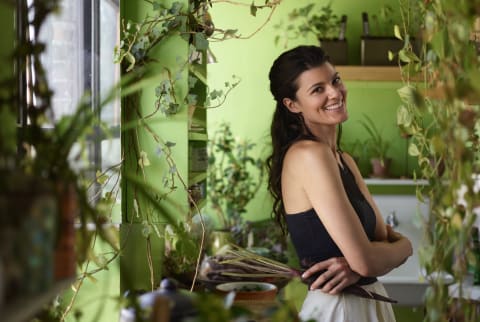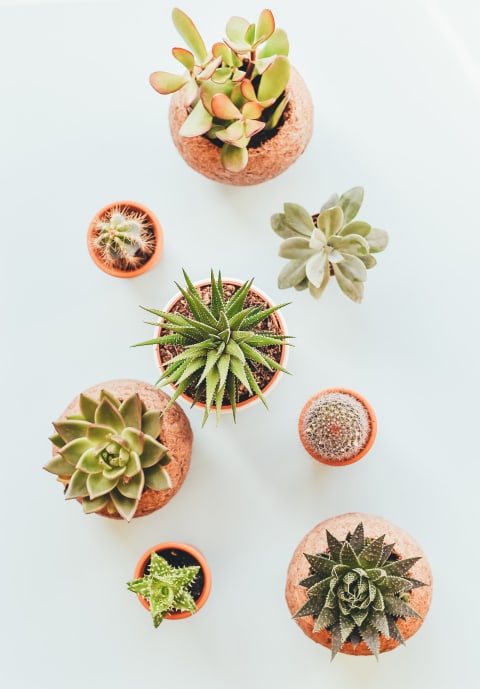Advertisement
Here's The Perfect Houseplant For You, Based On Your Home's Size & Light


As we head deeper into the throes of summer, the sun is getting stronger and stronger—which could spell bad news for your houseplants. Have no fear: In her new book, How To Make a Plant Love You, environmental scientist Summer Rayne Oakes provides hundreds of plant-care tips that are supported by rich botanical knowledge. In this excerpt, Oakes explains WHY lighting is so important to your home's greenery and shares how to optimize the light you have.
Monotropa uniflora is one of 3,000 species of nonphotosynthetic flowering plants that can survive without any light. It lives in the darkness of the forest floor and is pretty much impossible to grow inside your home (as a kid, I tried and failed!); it ultimately "saps" energy from chlorophyll-producing plants via underground mycorrhizal networks of fungi, earning it the name "mycoheterotroph."
The ghostly Indian pipe, whose waxy white flower head hangs down, slumped on its equally white stem, as if it were noosed, taps its roots into the webby, white filaments festooned between trees and fungi, such as those in the genera Russula and Lactarius. Without the beech (Fagus sp.) and hemlock (Tsuga sp.) trees, with their ability to photosynthesize; and fungus, with its ability to siphon and shuttle nutrients—and arguably without the rest of the forest ecosystem—you can't grow Indian pipe.
Plants have all sorts of tricks ‘up their leaves’ in order to sop up energy from the sun’s rays.
But not unlike Indian pipe's clever ways to extract what it needs, photosynthetic plants have all sorts of tricks "up their leaves" in order to sop up energy from the sun's rays. They can position their leaves toward the sun, like movable solar panels; they can increase growth of their stems so they can reach a faraway light source (hence why some plants get "leggy"—a term that describes elongated stems as the plant's terminal leaves search for a suitable source of light); and they can even shift around the sun-eating organelles inside their leaves to maximize light intake. Light is so vital to helping a plant thrive that its rate of growth is proportional to the intensity, quality, quantity, and even timing of the light that it receives. That's why considering light is an important first order of business for growing a plant indoors.
When it comes to light, there can be too much of a good thing!
Some people may think that giving plants more light is beneficial, reasoning that more light equals more food for the plants, but that's not always the case. It is certainly possible for plants to get too much sun. Just like people, plants can burn in the UV rays, some more easily than others. Plants that live in hot, harsh terrains have adapted to minimize their light intake or protect their cells from the intense rays of the sun. Adaptations include reflective, thick cuticular leaves; white, woolly hairs; the production of natural sunscreen made of anthocyanins, which is akin to our melanin; and a host of other protections. Some plants that can withstand such sun intensity include Mammillaria, Echeveria, Crassula, Opuntia, and Tephrocactus.

Here's the perfect plant for your space, based on your light situation.
For those of us who are new to plants, I understand that you may need a bit of initial guidance in identifying the right ones for your home, light, and lifestyle. Consider this chart a general guide to put you on the right path:
I have a very sunny windowsill and am hands-off when it comes to plants: Cacti and most succulents [e.g., Opuntia, Mammillaria, Astrophytum, Echeveria]
I have a very sunny windowsill and am attentive when it comes to plants: Herbs and certain flowering plants [e.g., Ocimum, Rosmarinus, Mentha, Pelargonium]
I have some direct sunlight and can accommodate a larger plant: Ficus elastica, Ficus lyrata
I have some direct sunlight and can accommodate a medium-size plant: Sansevieria [Dracaena] or Dracaena
I have some direct sunlight and can accommodate a hanging plant: Tradescantia
I have some direct sunlight and can accommodate a small plant: Saintpaulia
I have a bright but relatively sunless window and can accommodate a larger plant: Monstera deliciosa or Schefflera
I have a bright but relatively sunless window and can accommodate a medium-size plant: Bromeliad or Spathiphyllum
I have a bright but relatively sunless window and can accommodate a hanging plant: Scindapsus or Epipremnum or Philodendron
I have a bright but relatively sunless window and can accommodate a small plant: Peperomia
I have indirect light/a sunless window and am hands-off when it comes to plants: Aglaonema or Aspidistra
I have indirect light/a sunless window and am attentive when it comes to plants: Adiantum, Asplenium (or other ferns), or Maranta
Adapted from an excerpt from How To Make a Plant Love You: Cultivate Green Space in Your Home and Heart by Summer Rayne Oakes, published by Optimism Press, an imprint of the Penguin Publishing Group, a division of Penguin Random House, LLC. Copyright © 2019 by Summer Rayne Oakes.
Watch Next
Enjoy some of our favorite clips from classes
Enjoy some of our favorite clips from classes
What Is Meditation?
Mindfulness/Spirituality | Light Watkins
Box Breathing
Mindfulness/Spirituality | Gwen Dittmar
What Breathwork Can Address
Mindfulness/Spirituality | Gwen Dittmar
The 8 Limbs of Yoga - What is Asana?
Yoga | Caley Alyssa
Two Standing Postures to Open Up Tight Hips
Yoga | Caley Alyssa
How Plants Can Optimize Athletic Performance
Nutrition | Rich Roll
What to Eat Before a Workout
Nutrition | Rich Roll
How Ayurveda Helps Us Navigate Modern Life
Nutrition | Sahara Rose
Messages About Love & Relationships
Love & Relationships | Esther Perel
Love Languages
Love & Relationships | Esther Perel

















